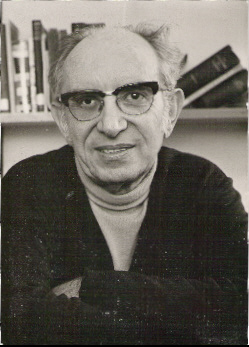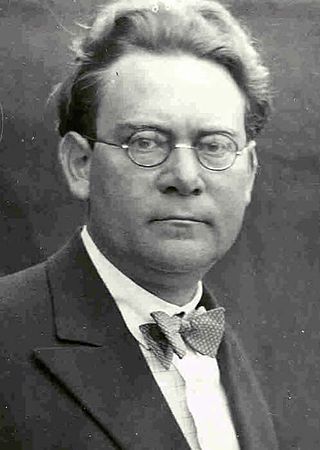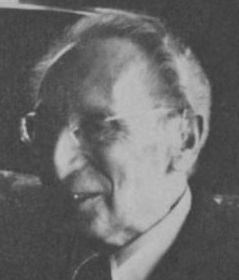Related Research Articles

Logical positivism, later called logical empiricism, and both of which together are also known as neopositivism, is a movement in Western philosophy whose central thesis was the verification principle. This theory of knowledge asserted that only statements verifiable through direct observation or logical proof are meaningful in terms of conveying truth value, information or factual content. Starting in the late 1920s, groups of philosophers, scientists, and mathematicians formed the Berlin Circle and the Vienna Circle, which, in these two cities, would propound the ideas of logical positivism.

Otto Karl Wilhelm Neurath was an Austrian-born philosopher of science, sociologist, and political economist. He was also the inventor of the ISOTYPE method of pictorial statistics and an innovator in museum practice. Before he fled his native country in 1934, Neurath was one of the leading figures of the Vienna Circle.

Rudolf Carnap was a German-language philosopher who was active in Europe before 1935 and in the United States thereafter. He was a major member of the Vienna Circle and an advocate of logical positivism. He is considered "one of the giants among twentieth-century philosophers."
Charles William Morris was an American philosopher and semiotician.

Mario Augusto Bunge was an Argentine-Canadian philosopher and physicist. His philosophical writings combined scientific realism, systemism, materialism, emergentism, and other principles.

The Vienna Circle of Logical Empiricism was a group of elite philosophers and scientists drawn from the natural and social sciences, logic and mathematics who met regularly from 1924 to 1936 at the University of Vienna, chaired by Moritz Schlick. The Vienna Circle's influence on 20th-century philosophy, especially philosophy of science and analytic philosophy, is immense up to the present day.

Yehoshua Bar-Hillel was an Israeli philosopher, mathematician, and linguist. He was a pioneer in the fields of machine translation and formal linguistics.

Carl Gustav "Peter" Hempel was a German writer, philosopher, logician, and epistemologist. He was a major figure in logical empiricism, a 20th-century movement in the philosophy of science. He is especially well known for his articulation of the deductive-nomological model of scientific explanation, which was considered the "standard model" of scientific explanation during the 1950s and 1960s. He is also known for the raven paradox.

Hans Reichenbach was a leading philosopher of science, educator, and proponent of logical empiricism. He was influential in the areas of science, education, and of logical empiricism. He founded the Gesellschaft für empirische Philosophie in Berlin in 1928, also known as the “Berlin Circle”. Carl Gustav Hempel, Richard von Mises, David Hilbert and Kurt Grelling all became members of the Berlin Circle.

Herbert Feigl was an Austrian-American philosopher and an early member of the Vienna Circle. He coined the term "nomological danglers".

The Kahlenberg is a mountain located in the 19th District of Vienna, Austria (Döbling).
The unity of science is a thesis in philosophy of science that says that all the sciences form a unified whole.
Verificationism, also known as the verification principle or the verifiability criterion of meaning, is the philosophical doctrine which maintains that only statements that are empirically verifiable are cognitively meaningful, or else they are truths of logic (tautologies).

Rose Rand was an Austrian-American logician and philosopher. She was a member of the Vienna Circle.
Marie Neurath, born Marie Reidemeister, was a German designer, social scientist and author. Neurath was a member of the team that developed a simplified pictographic language, the Vienna Method of Pictorial Statistics, which she later renamed Isotype. She was also a prolific writer and designer of educational books for younger readers.
Erkenntnis is a journal of philosophy that publishes papers in analytic philosophy. Its name is derived from the German word "Erkenntnis", meaning "knowledge, recognition". The journal was also linked to organisation of conferences, such as the Second Conference on the Epistemology of the Exact Sciences, of which it published the papers and accounts of the discussions.
The following is a bibliography of Charles W. Morris.
Neurath's boat is a simile used in anti-foundational accounts of knowledge, especially in the philosophy of science. It was first formulated by Otto Neurath. It is based in part on the Ship of Theseus which, however, is standardly used to illustrate other philosophical questions, to do with problems of identity. It was popularised by Willard Van Orman Quine in Word and Object (1960).

Janina Hosiasson-Lindenbaum was a Polish logician and philosopher. She published some twenty research papers along with translations into Polish of three books by Bertrand Russell. The main focus of her writings was on foundational problems related to probability, induction and confirmation. She is noted especially for authoring the first printed discussion of the Raven Paradox which she credits to Carl Hempel and the probabilistic solution she outlined to it. Shot by the Gestapo in 1942, she, like her husband Adolf Lindenbaum, and many other eminent representatives of Polish logic, shared the fate of millions of Jews murdered on Polish soil by the Nazis.
The Rudolf Carnap Papers are a large collection of documents and photographs that record much of his life and career. They are used by scholars and historians not only for research into the life of Rudolf Carnap but also for research into his theories and the theories of other scholars with whom he corresponded. The Carnap papers are restored, maintained, cataloged and housed in the Archives Service Center, University Library System, University of Pittsburgh. They include extensive correspondence with others, lecture outlines for courses that he taught, and drafts of his published works and unpublished manuscripts. Much of the content of the Rudolf Carnap papers is available electronically and searchable through the finding aid through the archives. His work on metaphysics being essentially a question of semantics is still cited and have been further expanded by other scholars. His papers document his being considered a major contributor on the question of metaphysics. He was also a member of the Vienna Circle.
References
- ↑ Neurath, Otto (1983) [1936]. "An international encyclopedia of unified science". In Cohen, Robert S.; Neurath, Marie; Fawcett, Carolyn R. (eds.). Philosophical papers, 1913–1946. Vienna Circle collection. Vol. 16. Dordrecht; Boston: D. Reidel. pp. 139–144. doi:10.1007/978-94-009-6995-7_12. ISBN 9027714835.
- ↑ Neurath, Otto; Carnap, Rudolf; Morris, Charles W., eds. (1969) [1938]. Foundations of the unity of science: toward an international encyclopedia of unified science. Chicago: University of Chicago Press. p. 103. ISBN 0226575861. OCLC 186129.
- 1 2 3 4 5 Stadler, Friedrich (2015) [2001]. The Vienna Circle: studies in the origins, development, and influence of logical empiricism. Vienna circle institute library. Vol. 4 (Abridged and revised ed.). Cham: Springer Verlag. doi:10.1007/978-3-319-16561-5. ISBN 9783319165608. OCLC 911018849 . Retrieved 22 November 2017.
- 1 2 3 Hollinger, David A. (May 2011). "The unity of knowledge and the diversity of knowers: science as an agent of cultural integration in the United States between the two world wars". Pacific Historical Review . 80 (2): 211–230 [216–217]. doi:10.1525/phr.2011.80.2.211.